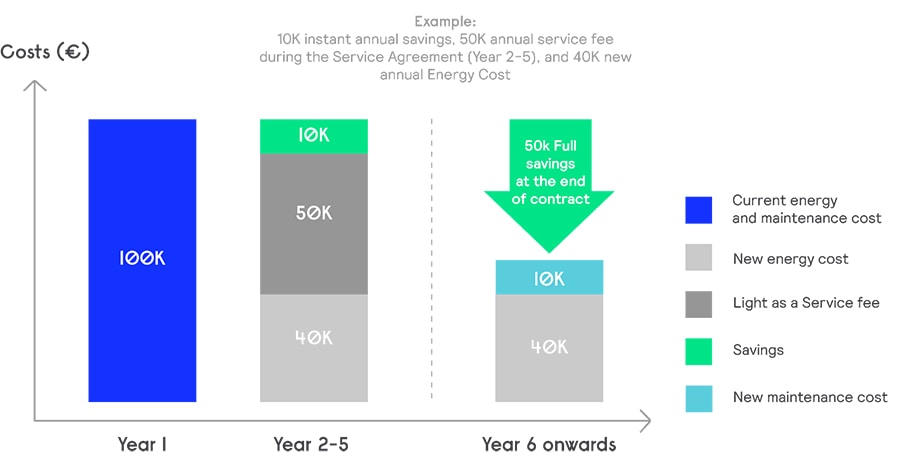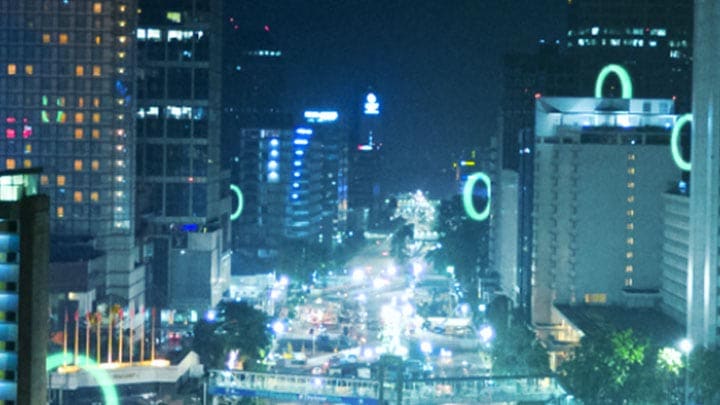Connected lighting uses two-way data communications, opening up a broad range of data-enabled capabilities and offering benefits that go beyond illumination.
Connected lighting systems collect and store two kinds of data: operational data from the lighting system itself —operational status, energy consumption, and burning hours, for example—and data collected from the illuminated environment via sensors hosted by the lighting system —such as weather and traffic conditions, air quality, humidity, noise levels, and daylight levels. LaaS offerings use both these kinds of data.
Professional connected lighting systems bring energy savings of up to 80% over conventional lighting systems and significant reductions in lighting-related greenhouse gas emissions. Additionally, connected lighting elevates the experience with advanced capabilities such as lighting personalization, indoor location services, and environmental monitoring.
An open systems approach that allows integration of connected lighting with other connected services in a building or municipality can help build smart ecosystems that comply with emerging climate and health and well-being standards, such as LEED, WELL, and smart city standards from the IEEE SA.
As with other as-a-service models, a LaaS customer buys lighting behaviors and a guaranteed lighting performance on a contract basis, rather than purchasing and managing any lighting fixtures, networking hardware, or system management tools and applications. The customer thus enjoys all the benefits of targeted and properly managed professional lighting, but without the capital expenditures (CAPEX) that such a system typically requires.
Connectivity and cloud computing make LaaS both possible and attractive for professional organizations of various kinds. With cloud-based lighting management software, a LaaS provider such as Signify can remotely monitor, manage, and control all of a customer’s lighting assets through web- and browser-based dashboards and software applications.
Systems technicians can monitor all light points in real time, access up-to-the-minute performance and status data, and control light points manually when needed. System automation radically reduces maintenance complexity and repair times, ensuring lighting uptime and performance while lowering costs.
With LaaS, a customer buys light rather than a lighting system. With no down payments or upfront investments, businesses can enjoy instant savings, positive monthly cash flow from day one, enhanced savings with utility and government tax incentives, and lower maintenance costs.

In 2022, the NSG Group engaged with Signify to install a suite of cutting-edge smart lighting technology at its Lathom and Redditch sites in the UK. The lighting upgrade aligns with the company’s aim to be the global leader in high-performance glass and glazing solutions, which support energy-efficiency measures and regulations in buildings.
The NSG Group signed a LaaS agreement with Signify that includes full turnkey installation and execution services with no up-front CAPEX or cost. The system provided immediate savings, positive cash flow, and the reassurance of continuous maintenance and guaranteed high performance through the duration of the ten-year contract.
The company’s sites are expected to save 170 tons of CO2 each year via the new energy-efficient solution. Additionally, the wirelessly controlled LED luminaires that Signify installed also provide a number of smart factory benefits, including data-driven insights that can help to make operational decisions.
In support of Leonardo UK’s sustainability strategy, the aerospace company has signed a ten-year LaaS agreement with Signify that includes the full turnkey installation of LED lighting with Interact lighting management software across 14 buildings at its Yeovil site in Somerset county. The lighting in each building has been carefully designed to ensure a safe and productive work environment for the 3,300 highly skilled personnel.
The Leonardo contract is performance-based, guaranteeing light level, energy, and uptime targets for the contract’s duration. The new lighting system required no upfront capital investment from Leonardo. Instead, the company pays Signify an annual operating fee, allowing them to realize cash-positive savings from the first year. Once completed, the program is expected to reduce Leonardo's location-based CO2 emissions by an estimated 725 tons per year.
In 2024, Signify published a Climate Transition Plan that emphasizes the key role energy-efficient products and services play in increasing energy efficiency and reducing greenhouse gas emissions. This is especially important for lighting products and systems, as the use phase of lighting products typically accounts for more than 99% of total emissions across a product’s lifecycle.
Using more energy-efficient products to increase energy efficiency seems self-evident, but how to transition to energy-efficient products, and how to use them most effectively, is not obvious. For this reason, Signify employs an end-to-end LaaS model that defines explicit energy-efficiency goals at each service phase.
The plan and design phase evaluates a customer’s existing lighting assets, compares them to the project scope and efficiency objectives and identifies areas for improvement. Baseline metering assesses current light levels and energy consumption.
A detailed lighting design solution is created, based on audit data and business objectives. Systems design includes control recommendations for maximizing energy savings while minimizing operational costs, service design identifies KPIs and a verification plan to keep the system operating in line with business objectives, and a comprehensive business case details the financial impact of the proposed solution.
In the system execution phase, efficient and professional installation and commissioning ensure that all aspects of the lighting system are implemented such that energy-efficiency and carbon reduction targets can be achieved.
In the operate phase, Signify continues observation of the performance of the lighting system to ensure everything runs properly, checks system operations, consults on faults, and manages content (where necessary). This is done on-site with the customer as well as remotely through the lighting management software.
In the maintain and optimize phase, recurring services are provided that include maintaining and repairing the lighting solution as required, optimizing performance throughout the contract, and verifying agreed performance. This includes preventive and corrective maintenance, spare parts supply, documentation and training, data analytics, reporting and consulting, and system optimization.
Head of External Communications - Signify
Tom Lodge
Tel: +31 6 52525416
Email: tom.lodge@signify.com
Signify (Euronext: LIGHT) is the world leader in lighting for professionals and consumers and lighting for the Internet of Things. Our Philips products, Interact connected lighting systems and data-enabled services, deliver business value and transform life in homes, buildings and public spaces. In 2022, we had sales of EUR 7.5 billion, approximately 35,000 employees and a presence in over 70 countries. We unlock the extraordinary potential of light for brighter lives and a better world. We achieved carbon neutrality in our operations in 2020, have been in the Dow Jones Sustainability World Index since our IPO for six consecutive years and were named Industry Leader in 2017, 2018 and 2019. News from Signify is located at the Newsroom, Twitter, LinkedIn and Instagram. Information for investors can be found on the Investor Relations page.
